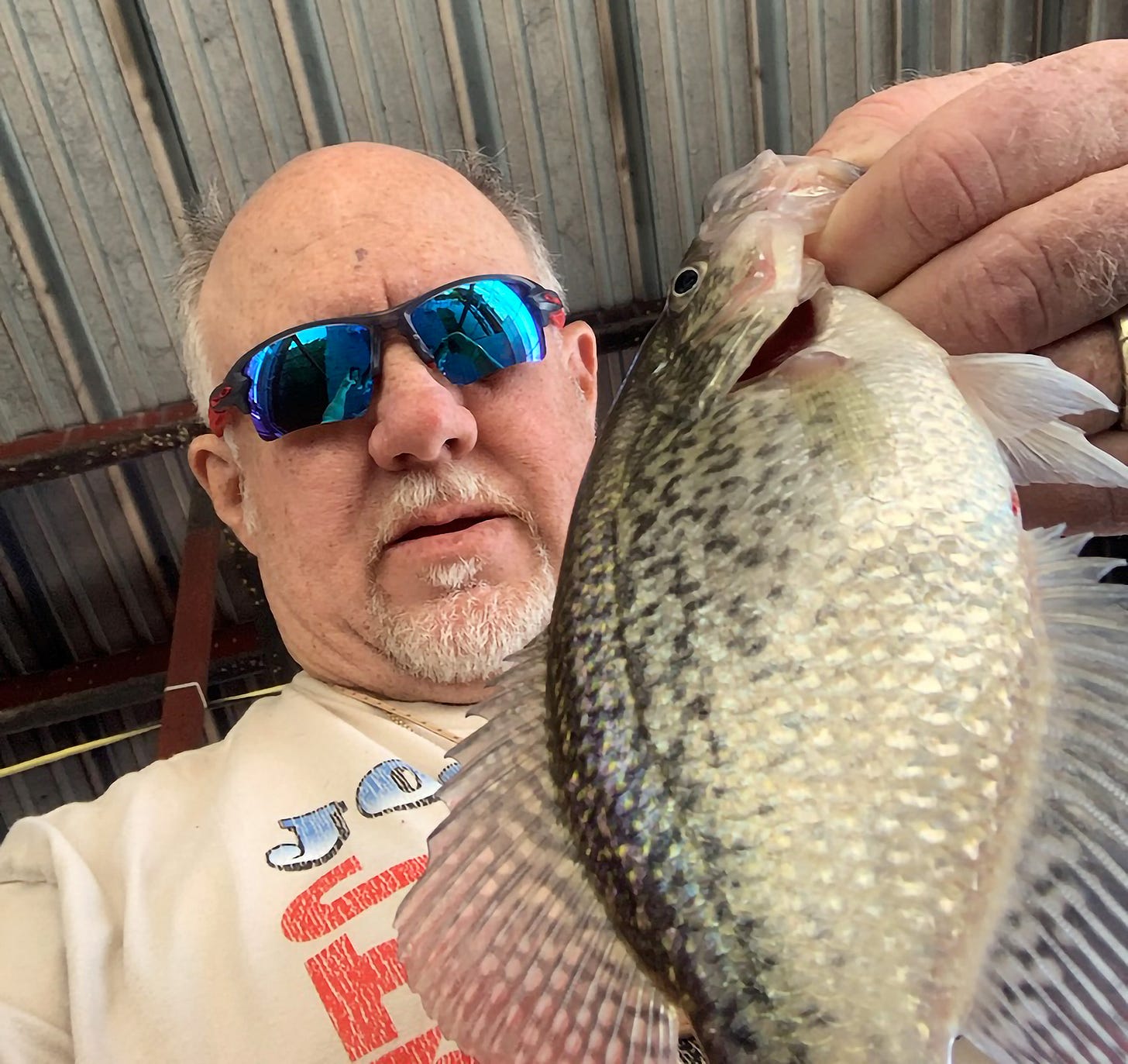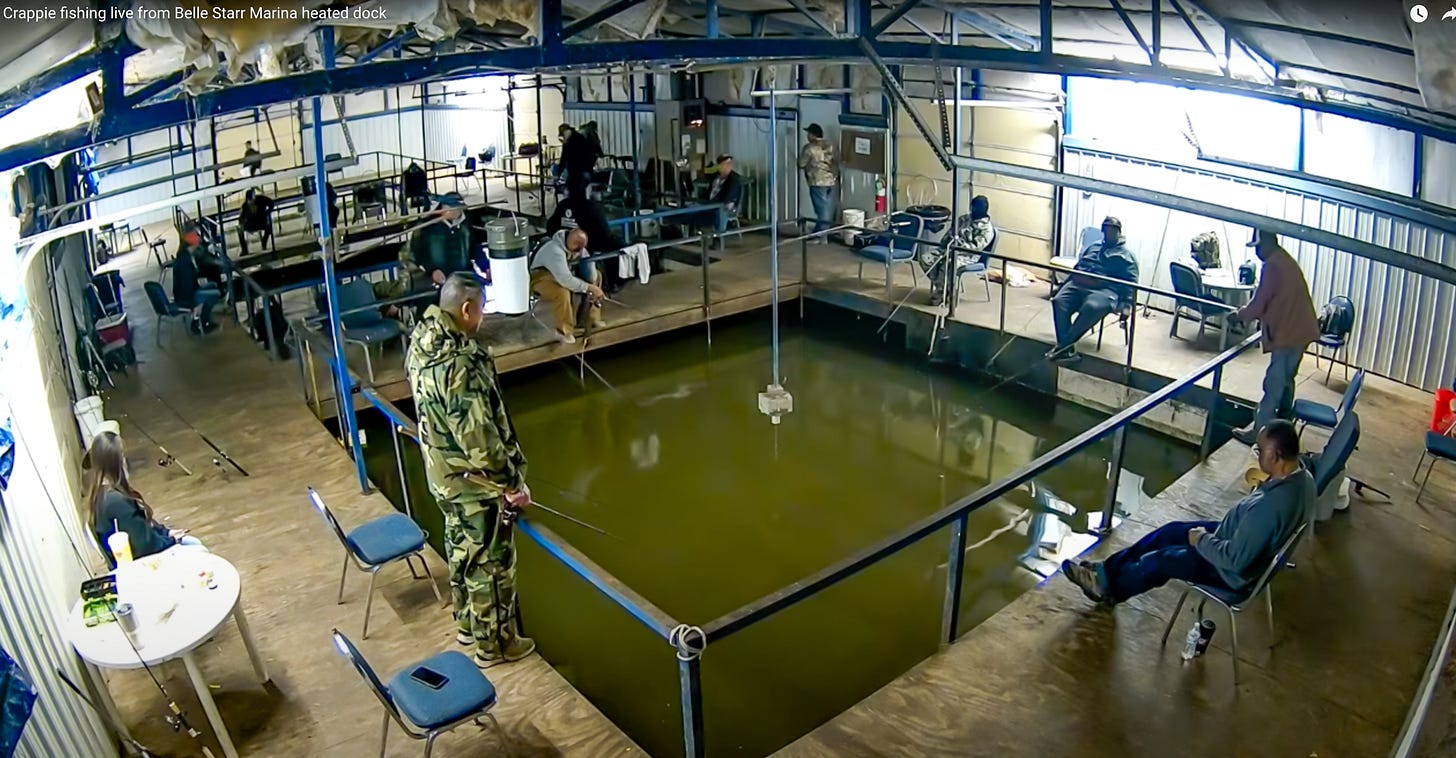A heated topic for crappie anglers old and young
Angler Darrell Purser takes up cause to build more heated winter crappie docks

Just a hair over freezing with biting wind from the north, a miserable day in Oklahoma, by most accounts.
But there they are in their lawn chairs, older folks, if we can take a hint from the woman’s white hair and the man’s coat and hat that have grown vintage along with their owner.
He has his pole dangling off the dock, line drooping to a float he’s watching while his mind no doubt wanders and he waits for a wiggle. Her lawn chair is close to his, angled for a nearer presence, showing the comfort in their bond as she reads her book.
The live feed of Belle Starr Marina’s heated fishing dock shows a fine view of the couple and several others dipping lines for crappies on an early spring day. The same goes for any day all winter long. Looks like a younger couple on the other end of the building have a couple of youngsters with them.
Talk to Darrel Purser, and he will tell you that this scenario has become all too rare in Oklahoma. He’ll be downright insistent on that point.
He said he’s consulted Christ, is ever moved by the great I Am, and is determined to share his passion for heated crappie docks with effect as he edges near his retirement years.
Make no mistake, this will be one helluva retirement gig.
Challenging, that is.
A dedicated follower of Christ and passionate fisherman and hunter of at least 55 years, he told members of the House Wildlife Committee about his ongoing mission late in 2024. He convinced them to convene an Interim Study on the subject.
“I was praying to Christ, wondering, why are these going away? And then he told me. He said, ‘You have to do it for the other people and not just for yourself.’ And that’s why I have such a passion for this.’”
Wildlife Committee members seemed to understand and appreciate the dilemma he detailed in a 35-minute PowerPoint presentation. He covered everything from crappie habitat and fishing dock placement to the health risks associated with cabin fever. However, from a state governmental funding and logistics standpoint, it didn’t fall within their purview.
So comes a future retirement for Purser that will likely have him inexorably linked with the Oklahoma Department of Wildlife Conservation, countless municipalities, community groups, and counties, and, with luck, loads of generous benefactors.
It is no small task to provide young families, seniors, Wounded Warriors, disabled people, and anyone looking for an affordable and sheltered place to fish during Oklahoma’s coldest winter and early-spring spells.
Still, he said he is up to take on that mission.
So, what’s the deal with heated docks?
Crappie docks are to Northeast Oklahoma as ice-fishing houses are to Minnesotans and Dakotans. The problem is that we can’t park a truck on the ice here, and if you don’t own a sizeable boat or know a friend with a sheltered fishing dock, accessible spots to fish comfortably are nonexistent.
Coming from Alaska—where we parked our trucks on the lake and bought drill extensions to get through five feet of ice—this concept was lost on me when I first moved here. I was still oblivious to what Okies called “cold” and didn’t mind casting a line in crappy weather.
But my Tulsa World predecessor, outdoor writer Sam Powell, called one day in 2010 and told me crappie docks were disappearing and that I needed to experience it. He advised that I plan to arrive early and include hashed browns, bacon, and eggs as part of the experience.
I found the story at the Molly Brown Cafe at Eufaula Marina. There, owner Bill Brown said his dock was the world’s largest. Purser tells me that the marina has since switched to bar and grill service only and is now up for sale.
My column listed a dozen northeast Oklahoma docks that were at least covered. Most were heated, and several had adjacent food services.
The bottom line: It’s tough to put a value on making this kind of experience widely available during colder months. Invluable is the word. The tricky thing about our priceless outdoor experiences is that they have an actual price tag.
Fifteen years later, Purser reports only five enclosed docks are within an hour’s drive of Tulsa.
He and I do part ways on that statistic—wink.
I live south of town in Bixby, which puts docks at Lake Eufaula and Greenleaf State Park within 60 miles of my house.
The best remaining is Belle Starr, Purser said. You can even peek inside at the Belle Starr YouTube channel, which includes the previously mentioned livestream.
Among the remaining five listed by Purser is Cypress Cove at Fort Gibson Lake. Although it burned down in 2023, it has nearly been rebuilt. A fee box is located at the heated fishing dock. However, the schedule is flexible due to construction, and the marina’s Facebook page advises people to check there or call 918-687-4073 before going.
Crappie docks are social gathering places, fantastic for kids new to fishing, and an excellent way for handicapped anglers or elderly folks (or anyone else) to reach a good fishing spot in winter. They offer an opportunity to beat cabin fever relatively cheaply in the winter months.
The bottom line: It’s tough to put a value on making this kind of experience widely available during colder months. Invluable is the word. The tricky thing about our priceless outdoor experiences is that they have an actual price tag.
The challenge ahead
Purser correctly points out that Oklahoma seniors, children, disabled, and wounded veterans will benefit from additional crappie docks. If you’re reading this column, you likely are among those who understand the mental and physical benefits of outdoor activities, especially during winter months.
With limited opportunities, more crowd to the few available docks, and fishing suffers from the pressure. Purser said that a well-designed dock should be over at least 20 feet of water to draw larger adult crappie and provide the various depths the fish use through changing conditions.
Purser said he has identified one ideal location on Oologah Lake at Spencer Creek for such a dock and that it already has a road nearby.
“I have recently been in contact with the Oologah Lake Office of the Corps of Engineers, and they are not even entertaining adding any docks,” Purser said.
Building a dock won’t require any adjustments to water levels, but if the construction is on Corps land, it would add to the responsibilities of Corps rangers and other personnel. That said, I’ve read that the Corps accepts private donations, which might allow him to pursue the issue further.
As always, it comes down to politics and money.
Purser heard about it at the State Capitol early this winter, as the microphone at that House Wildlife Interim Study microphone passed to Nate Copeland, Boating and Fishing Access Coordinator for the Oklahoma Department of Wildlife Conservation.
Copeland said he could relate to Purser’s concerns and said the Wildlife Department recognizes the importance of providing fishing access as part of its mission. Balancing development and grants available for the small corps is an ongoing challenge.
About 25% of most projects are funded by the Wildlife Department, with the remainder under a qualifying grant under the federal Sportfish Recreation Fund.
Another 25% match is required from a “cooperator,” be it a federal, municipal, or county agency or a non-profit. Before a build can begin, Copeland said a signed cooperative agreement is necessary to guarantee the upkeep and maintenance of that facility for the 20-year life of the dock.
Federal Buy America, Build America compliance, originated under the Biden Administration’s Infrastructure Investment and Jobs Act in 2021, is also required. That means all the hardware and building materials must be domestically produced or sourced. According to Copeland, that demand has sometimes exacerbated planning hurdles and caused delays.
Local municipalities, counties, and federal agencies typically are the stable entities that make those long-term cooperator commitments, but private entities and non-profits can make it work, too.
Under the public grants, the facilities must be public, Copeland added, so while an entity may charge for a lake fishing permit, it cannot charge for access to the dock—at least not for the initial 20 years.
Copeland said the bare minimum for an enclosed dock, parking, and access runs about $174,000. That means the cooperator’s match has to be about $43,000. They will need an annual budget of about $6,700 for cleaning and repairs—including inevitable vandalism.
Copeland offered that a $5 fishing permit added to a lake would require about 1,400 people to buy those permits to break even annually on a crappie dock alone.
“I’m not saying it’s not a worthy cause,” Copeland said. “But when you get to the finance side, you have to know what you’re getting into.”
Purser seems well aware of the challenge ahead and is pressing forward, God bless him. It will take perseverance and patience, but he is a man of God and a fisherman to boot. Let’s all pray his devotion to crappie docks pays off for Oklahomans.




